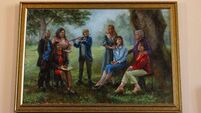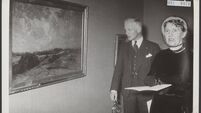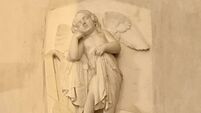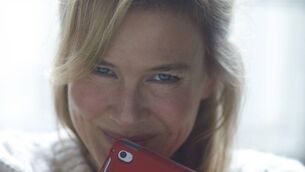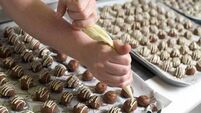Clodagh Finn: Recalling Sarah Purser and her towering ambition
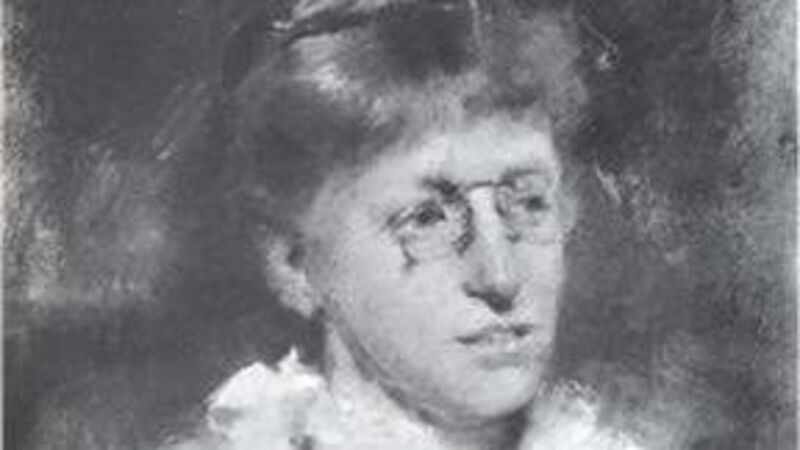
A Walter Osborne portrait of Sarah Purser, who may have had the largest fortune any Irishwoman amassed by her own unaided efforts, thanks to an investment in Guinness.
Sarah Purser, artist and founder of An Túr Gloine (the Tower of Glass), the stained-glass cooperative which opened its doors 120 years ago on New Year’s Day, still has the power to inspire — and distract.
I set out to mark the anniversary of a pioneering studio that brought together artists such as Harry Clarke, Evie Hone, Michael Healy, and Wilhelmina Geddes, but found myself getting ambushed by the details of the extraordinary life of its exuberant, determined, and criminally under-the-radar founder.
And little wonder. Take this magnificent anecdote, for example. Annoyed by her landlord’s repeated failures to repair the roof of her house, an octogenarian Sarah Purser boarded her friend Oliver St John Gogarty’s personal plane — he was a talented amateur aviator — and carried out her own aerial inspection.
A decade later, just before her death aged 95 in 1943, she had an argument with President Douglas Hyde about the quality of a portrait of him that had appeared on a stamp.
As a younger woman, in her thirties, she spotted the potential of Guinness brewing company in the early days and invested heavily in its stock.
HISTORY HUB
If you are interested in this article then no doubt you will enjoy exploring the various history collections and content in our history hub. Check it out HERE and happy reading
In 1962, writer Elizabeth Coxhead estimated that Purser had “the largest fortune, it is fair to say, that any Irishwoman has ever amassed by her own unaided efforts”.
Her own wealth had particular resonance because the family, of Dublin and Waterford, endured exceptionally difficult times when Sarah’s father Benjamin Purser went bankrupt and moved to the United States in the 1870s. Sarah, then a student at the Metropolitan School of Art in Dublin, never saw him again.
She settled in Dublin with her mother, “in very modest terms, letting it be known that she [her mother] didn’t expect any friends to call on them”, according to Elizabeth Coxhead.
Sarah, understandably, resolved to become financially independent. She had two choices of career — she could play the piano or she could paint. As this newspaper observed in 1976: “She decided to become a painter, arguing that portraiture could be made to pay, and present her with an agreeable mode of living, whereas the life of a music teacher (the only prospect she could see in the field of music at the time) was distasteful to her.”
With a loan of £30 from her brothers, she set off to study at the Académie Julian in Paris in 1878. Despite “the rigours of life in Paris on an income of £1 a week”, she did well there, meeting female artists from all over Europe. She returned to Dublin after a year, rented a studio, and was lucky enough to get a highly-paid commission to paint Miss Jane l’Estrange of Sligo.
Growth in popularity
It was the start she needed, as Sonja Tiernan explains in Irish Women’s Speeches, Volume ll. Lady Georgina Gore-Booth of Lissadell House was so impressed by the painting that she commissioned a portrait of her daughters, Constance (later Countess Markievicz) and Eva. In turn, that portrait prompted a host of new commissions from family friends.
As Purser wryly said, she was so popular she “went through the aristocracy like the measles”.
One account attributed that popularity to “her honest, straightforward and often sensitive works”, noting that she was as much in demand as William Orpen.
Her success, though, was exceptional. Between 1887 and 1890, writes Sonja Tiernan, “she had more portraits exhibited in the prestigious halls of the RHA [Royal Hibernian Academy] than any other artist, a significant accomplishment for any painter, but all the more noteworthy for a woman in a then male-dominated environment.”
Honorary membership to the RHA followed. Full membership for women was not granted until 1919, but it was 1924 before Sarah Purser and Mary Swanzy became full members.
At the time, critic and later director of the National Gallery of Ireland Thomas McGreevy wrote: “The dissenting members of the board of the RHA might consider what the world will think if they persist in excluding women. It will think it is because the women are better artists than themselves.”
But we are getting ahead of ourselves. At the end of the 19th century, Sarah Purser’s hard work brought her recognition, security, and money which she wanted to use to promote Irish art and artists.
She was to the visual arts as Lady Gregory was to theatre, as one tribute put it, noting that in 1901 she had financed “that important joint exhibition of Nathaniel Hone and John Yeats which roused Hugh Lane to a recognition of the standard of Irish art”.
That exhibition inspired Lane’s dream of setting up a gallery of modern art in Dublin; a venture he would pursue with the help of Sarah Purser and others.
By 1902, the idea of a modern art gallery was firmly implanted. A year later, exactly 120 years ago, Sarah Purser was about to see her vision of establishing an Irish stained-glass workshop become a reality.
On New Year’s Day 1903, artists were invited to 24 Upper Pembroke Street in Dublin where they gathered around the kiln in a new but “oh, so cold” workshop and drank champagne out of tea cups.
It was a pivotal moment for Irish artists as An Túr Gloine aimed to provide an alternative to the mass-produced and inferior glass being imported from Europe. Stained glass might be “the thing that is more intoxicating than all the wines of the world”, Purser said, quoting Chesterton, “but it was also the most troublesome and expensive to make”.
“You cannot do it in a romantic studio with silk cushions, but must work in a grubby work shop, and must have kilns, and a large stock of glass, etc., and someone to cut and glaze, etc, for you,” she went on, explaining that a co-operative would help train artists and allow them to produce work of quality.
In the early days, Lady Gregory and WB Yeats called to the studio to see the work in progress, but they were not impressed. Yeats wrote an article suggesting that Purser was giving in to the demands of commercialism.
Purser was swift and forthright in her response. She said the poet had not received an invitation to the studio and his treatment of her went “beyond the limits of decent manners and is conduct which would make all social intercourse impossible”.
They patched up their differences, however, and Yeats was among the writers, artists, and poets who visited her monthly salon at Mespil House in Ballsbridge, which she leased in 1909. It was a place “full of bubbling gaiety”, critic and editor Mary Colum wrote.
Art heritage
In the outside world, Sarah Purser’s trademark exuberance and determination were also evident. In 1912, she was appointed to the Mansion House committee to develop plans for a modern art gallery. Two years later, she was appointed to the board of governors of the National Gallery of Ireland. When her friend Hugh Lane went down with the Lusitania in 1915, she set up the Friends of the National Collections of Ireland to preserve Ireland’s art heritage.
She continued to paint too and, in 1923 aged 75, she held her first solo exhibition.
By the time she retired from An Túr Gloine, when she was in her nineties, the collective had produced thousands of high-quality stained-glass windows for buildings here and across the world. “It is almost certain,” says Sonja Tiernan, “that every day, somewhere in the world, a person looks in admiration at a stained-glass window produced through her efforts”.
Her work is known all over the world. Maybe now, on the 120th anniversary of the opening of her famous stained-glass workshop, her name will be too.

Subscribe to access all of the Irish Examiner.
Try unlimited access from only €1.50 a week
Already a subscriber? Sign in
CONNECT WITH US TODAY
Be the first to know the latest news and updates




